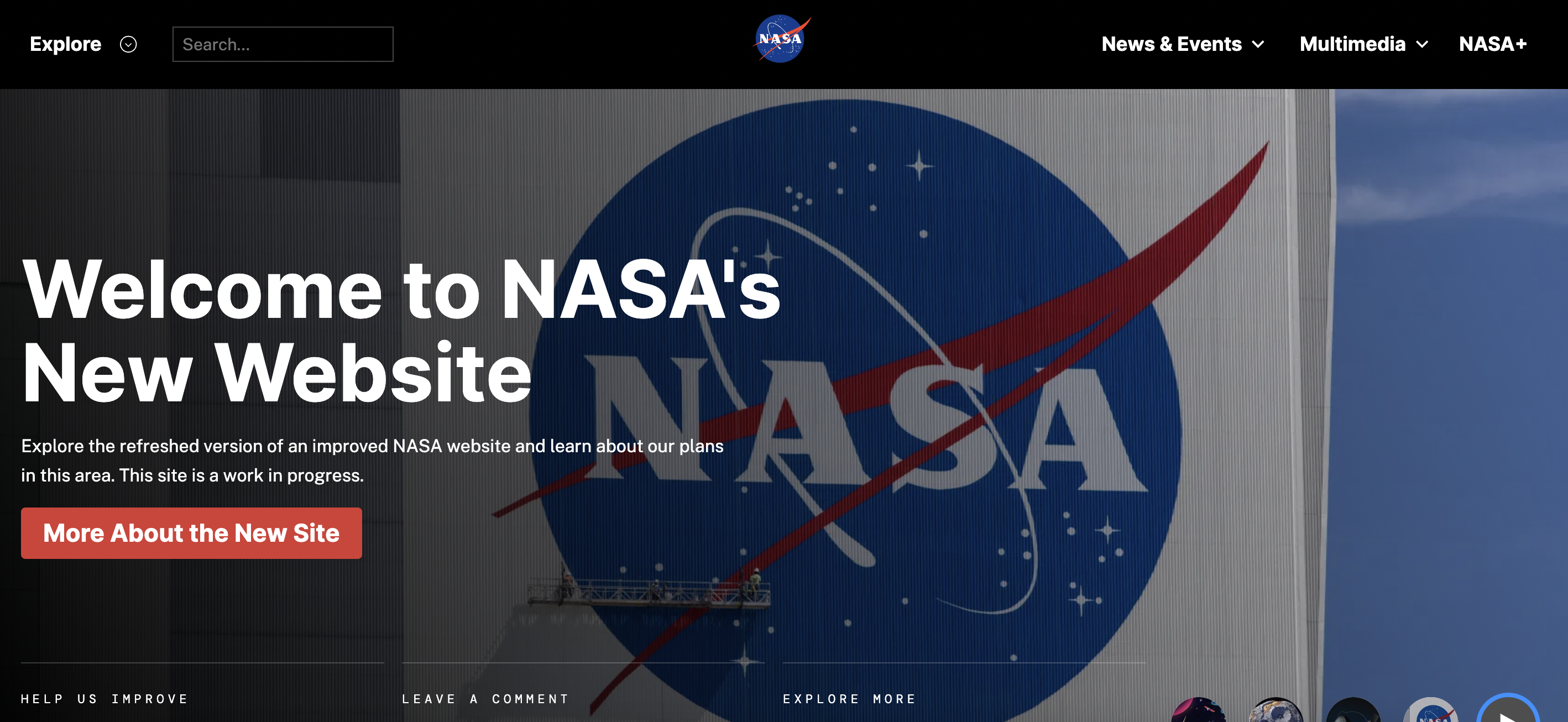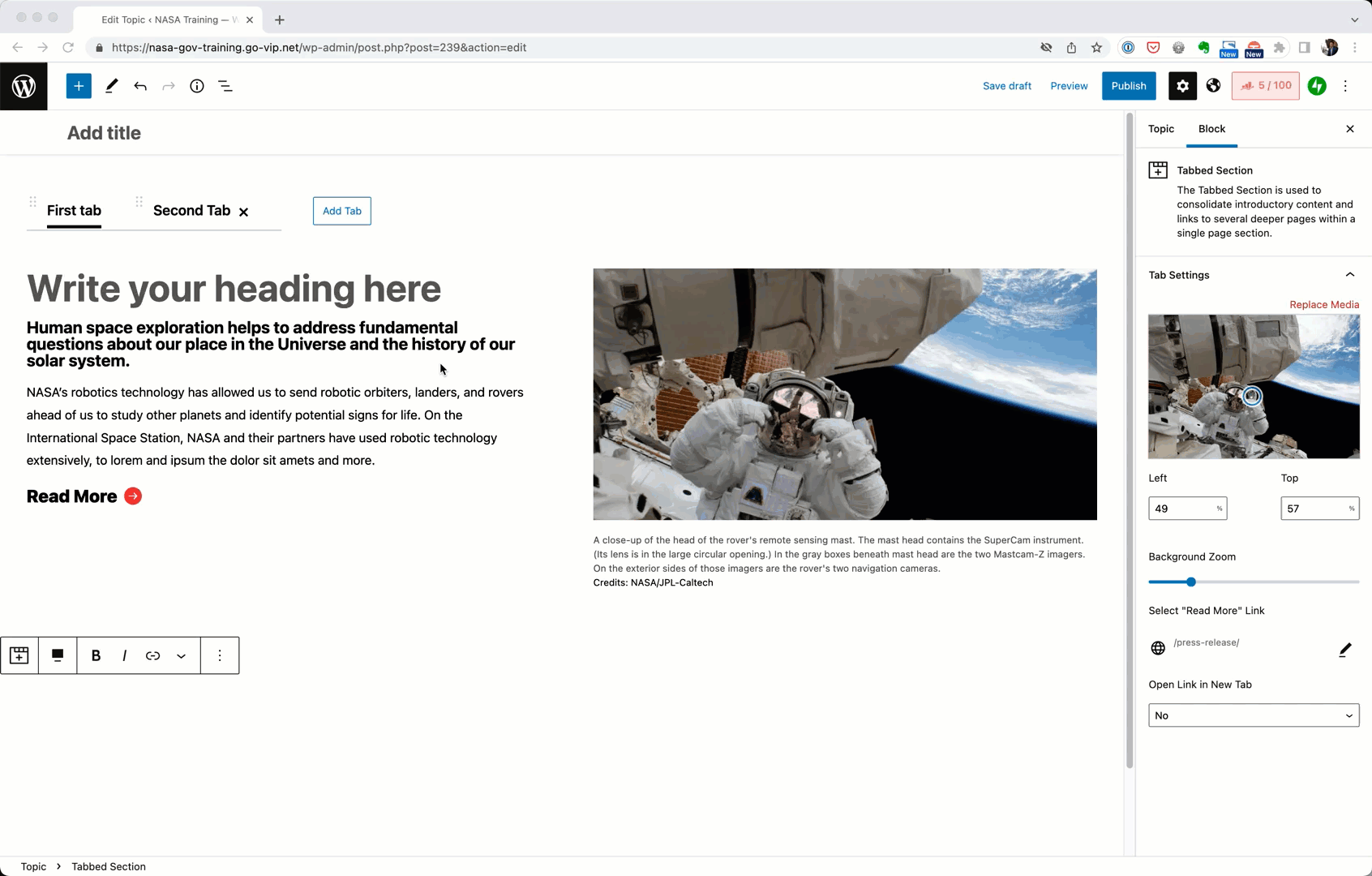
NASA has removed the beta label from the new nasa.gov website, which was launched on WordPress, replacing Drupal as the CMS. After a lengthy process, which required 18 months of active web development, data migration, and content building, NASA has emerged with modernized flagship and science websites, showcasing the innovation and discoveries that have defined the agency for more than 65 years.
The multi-million dollar project began a few years ago when a combination of the IDEA Act and Drupal 7 EOL provided an opportunity for NASA to reconsider the CMS they were using for nasa.gov. Lone Rock Point, a WordPress.com VIP Gold Agency Partner, led the project, which began with a year of UX design and an evaluation of various enterprise CMS’s that would ultimately end up supporting 456 CMS users, 68,698 migrated pages, and 3,023 new landing pages. As part of the project, NASA’s website infrastructure was migrated from an Amazon Web Services environment to WordPress.com VIP.
“In earlier discovery phases of the project, content authors were were vocal that they were interested in a CMS that allowed them to break free of templates that were perceived to be rigid,” Lone Rock Point President J.J. Toothman said. “The block based authoring approach of Gutenberg is delivering on that and user testing showed that WordPress could provide that. Now that the site is live, the different types of landing pages being created with block based approach further validates that.”
NASA evaluated both proprietary and open source solutions, and Toothman said they took a high level look at over a hundred CMS platforms. They narrowed it down to four CMS’s – two were commercial and two were open source (WordPress and Drupal). The team completed high level prototyping and user evaluation on all four of the finalists, and used this data in the CMS selection process.
Toothman outlined a few of the factors that set WordPress apart from the others:
- Access to resources. Simply put, there’s a huge community around WordPress. That community is extending WordPress in innovative ways; sharing knowledge and training for WordPress; and continuously building up WordPress skills amongst the community. That makes it easier for an organization like NASA to acquire support. There’s options for that. What was found with commercial CMS solutions is that, more often than not, NASA would have to go back to the original CMS vendor to find resources. That’s limited flexibility, which is undesirable for them.
- A plugin ecosystem that delivered real time content analysis capabilities within the WordPress admin environment in the ares of SEO and accessibility. The fact that content could be analyzed by the author before it was published was significant.
- Ease of use of the content authoring environment
“It’s a big win for open source,” Toothman said. “There were a number of CMS capabilities that would have been more time consuming to implement without previous work by others in the WordPress community.”
He cited the integration that the NASA WordPress site has with NASA’s image library at images.nasa.gov as one example. Content authors in the CMS can search for images in the library and include them in their content via an augmentation that was made to the WordPress media library. Human Made did some previous work with commercial digital asset management solutions that NASA was able to leverage for the images.nasa.gov integration.
NASA Goes All In on WordPress’ Block Editor
The block editor’s flexibility for authoring landing pages and breaking free of a rigid templating system was one of the most important factors in NASA’s selection of WordPress as a CMS. As part of the project, Lone Rock Point created 55 custom editor blocks to help NASA website authors share discoveries and tell their stories.

“There’s over 400 content authoring/editor users in NASA’s WordPress CMS,” Toothman said. “With that many users, there’s a lot of variance in pre-existing familiarity to WordPress and Gutenberg. It was challenging. The learning curve was more significant than expected and change management was a big part of this project.
“Some took the block editor quickly, others needed more support. It wasn’t just learning the mechanics of a new CMS, but learning about the storytelling options available via the new design system and the block editor. We built a lot of custom of blocks to bring the design system to live in WordPress, while also attempting to adhere to the intention of those design system components.”
Toothman and his team found strategic ways of helping new block editor users become familiar with the authoring tools. They created hands-on training and working sessions to build pages in real time alongside users and created an online knowledge base.
“To encourage the user community as they learned the new CMS, we created weekly blogs and newsletters that featured screenshots of pages in progress,” Toothman said. “Seeing their peers’ work and out-of-the-box use of the custom blocks, users were inspired to try different things and ask more questions. Our content team held weekly office hours for managing editors to answer questions users may have, hold live demonstrations, and collect feedback to produce more user resources.
“By creating an environment that invites discussion, collaboration, and creativity, the content team was able to enforce content quality control standards on a massive scale while delivering a high-quality end-user experience.”
Toothman said he was surprised and delighted by the creative ways authors utilized certain blocks.
“Content authors figured out ways to use some of the custom Gutenberg editor blocks as design layout options and broke free of the content intention they were originally designed for,” he said.
NASA will be open sourcing some of its custom blocks and other pieces of the project to give back to the WordPress community as part of the roadmap. The completed project stands as a high-profile testament to the agency’s confidence in the block editor and the wider ecosystem of available tools. It also highlights WordPress as a reliable CMS with exemplary adaptability for enterprise-level projects with complex publishing requirements.
“For years, myself and many of us in the WordPress community have been mythbusting the perception from customer stakeholders in 2 areas: (a) WordPress isn’t enterprise. It’s just a blogging platform. (B) WordPress is not a secure CMS,” Toothman said.
“While I don’t expect NASA choosing WordPress to wipe out those pre-existing perceptions, it is further evidence to support the fact that WordPress is enterprise class, and that it can meet security benchmarks.”
This is very exciting and good news for WordPress (after a rough couple of weeks) and for the Block Editor. Also, it’s great to see an article about bespoke / one-off website development. I’m a fan of the Block Editor and for several years used it exclusively for building custom (one time use) themes.
However, it’s been a struggle and a challenge. There is so little information out there for people doing this kind of work. It feels like everything is geared for creating public multi-use themes and commercial themes. I think a lot of the push-back on the Block Editor is developers like me or from agencies who need more information on how bespoke websites can be built cost effectively for their clients.